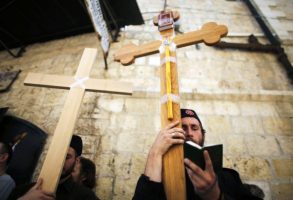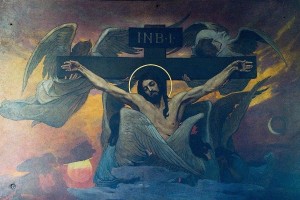How to be crucified with Christ
“I have been crucified with Christ” (Galatians 2:20)
Beloved in Christ,
Hierarchs, clergy and faithful
Of this God-protected Archdiocese:
The mystery of Christ is very simple. Yet in order to embrace it in our lives, we need a mind and a heart as humble as His. The mystery of His love to humankind is such that it surprises us, whenever we meditate on it and are conscious of it. It surprises us because it reveals the love He has for us. He “is love” (1 John 4:8), isn’t He?
Christ manifested His love to us in a very particular way: the way of a bridegroom with his bride. The Church preserved from the Lord’s last moments before death the image of a marriage. The “picture” she took of this wedding has been expressed in two different ways in our celebrations on the first days of Holy Week. In fact, we chant at Matins of these holy days:
“Behold the Bridegroom comes in the middle of the night…”,
and
“I see Thy Bridal Chamber adorned, O my Savior, but have no wedding garment that I may enter. O Giver of Light, enlighten the vesture of my soul, and save me.”
We also make a procession with the icon of the “bridegroom” with the inscription, “Behold, the man!” (John 19:5). It is the icon of the Lord of the “utmost humility,” the whole image of His passion, a snapshot of His unconditional love for us. It was the last picture taken of Him before His death on the Cross. It is the best picture ever taken of Him. The Church raises in front of our eyes this “picture” in order that we recall today in our hearts His love and humility, and commit ourselves again to follow Him on the way of the Cross.
The way of the Cross is not painful. The sufferings that Christ endured in His body did not hurt Him as much as did our indifference, ignorance, rejection and betrayal. We have heard His words to God the Father, on the eve of His crucifixion, in which He asked Him to “remove from Him the cup” (Luke 22:42), that is, the cup of our betrayal of His love. However, we all were also witnesses of how He wholeheartedly accepted the cup – accepted us as we are, in our own wickedness – to the end. This “end” was His love manifested on the Cross in His words of forgiveness: “Father, forgive them, for they don’t know what they are doing” (Luke 23:34), but also in His triumphal death: “It is finished” (John 19:30). He did love us to the very end of His life, and to the very end of our own misery, in order to accomplish our salvation, to restore in us love and the freedom to love each other as He did (John 13:34; 15:12).
Following Christ on the way of the Cross was, and still is, the very heart of the Christian “kerygma:” preaching and education. It instills in us the power of love that Christ handed over to His disciples throughout the centuries in order to befriend the “oikoumene,” that is, the whole world. Abiding by the way of the Cross has one finality: to bring every human being to the knowledge of the truth – to know the Father (Cf. John 17:3), to believe in the Lord as our Savior from death and evil, and to receive the gift of life eternal from the Holy Spirit. It is a journey that we begin in this earthly life and continue throughout eternity.
Practically, the way of the Cross is the same. It is “to be crucified with Christ” (Galatians 2:20), as the Apostle Paul exclaimed. I had this in mind when His Beatitude Patriarch John X of Antioch asked me to be the Patriarchal Vicar of this God-protected Archdiocese. Therefore, I want to ask that each of you, beloved members of this Archdiocese, see how you can “translate” such words in your own lives, behaviors and activities, in a practical, but heavenly, way. In fact, all of us together need to ensure that this transitional period preceding the election of a new Metropolitan, successor to His Eminence, Metropolitan Philip of eternal memory, be filled with the fragrance of the same love and faithfulness of the perfume that Mary poured out on Christ’s head (Cf. Matthew 26:7).
Mary’s pre-burial ointment prior to the Lord’s death (Cf. Matthew 26:12) prefigures our own way of following Christ in this transitional period, on the way of the Cross. Even though the disciples (or Judas) misinterpreted or condemned her action, the Lord asked that this ointment be a prefigurement of the announcement of His resurrection from the dead (Cf. Matthew 26:13). If we share this way, we also share the hope that the Lord proclaimed to Mary on the eve of His passion. As a fact, we will share the gladness that is coming forth from God´s promise to us: the fulfillment of our faith in Him.
I am sure that our Lord now “is working” (John 5:17) great things among us for our salvation. Let us follow Him on His way. Let us be His witnesses among our brethren. Let us be His trusted disciples in the service of our church and His co-workers for the salvation of the world.

















